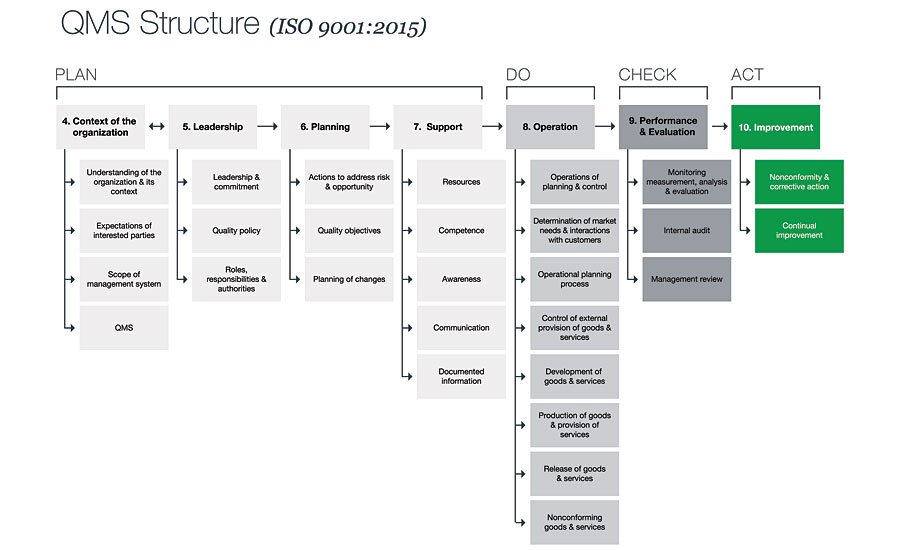Management
The Standard is Here
Learn more about the latest revision to ISO 9001.

Source: MasterControl

Source: MasterControl


The long-awaited revision to ISO 9001 has arrived. The standard will be familiar to those in the quality industry: more than 1.1 million companies are certified to the standard as of 2014, and more than 33,000 certifications in the U.S. Whether you’re in the process of implementing the revision, just planning for it, or curious to see what’s new, here’s a look at the ISO 9001 revision.
STRUCTURAL CHANGES
“What is going to bother people the most is that it is structured differently,” says Duke Okes, a consultant, trainer, and writer. “Imagine someone walked into your house, moved furniture and rearranged the bookshelf.” But he said, the new requirements aren’t huge, and there is more flexibility in some areas as well. In other words, you might grow to like the new arrangement.
MAKE IT A PRIORITYNo matter what standard you’re using, make sure it is implemented the right way. T.M. Kubiak recalls seeing companies develop a strategic plan, but then change it so often that they didn’t use it. Programs like Lean, Six Sigma or ISO should be used to reinforce this plan, but instead, Kubiak has seen some companies make programs optional, thus sabotaging themselves. “You don’t make strategies optional,” Kubiak says. “You don’t call upon the Lean Six Sigma leader to sell it.” And with ISO 9001, Kubiak noted that organizations should implement it without dragging it out. “If the quality system is helpful to people, then quality professionals also present themselves not as enforcers, but more as support,” says Praveen Gupta. The idea is to promote effectiveness rather than enforcement. People might not perceive value in the standard, but this version is a chance to change people’s minds. Most of the time, companies just want to get the standard crossed off the list, he says. “The perception is: ‘Go ahead, quality guy, you fix it,” Gupta says. “It is perceived to be finishing paperwork by a certain date.” |
Some of the terminology has changed as well, with no mention of a quality manual or management representative. “One thing that caused a lot of consternation at least for a while is that the 2015 edition no longer requires a management representative. Many people in charge of the QMS [quality management system] seemed to think they would be out of a job,” Okes says. “Obviously, not correct.”
He says someone will still need to oversee the system, but the new standard allows for more flexibility in doing so. The change also emphasizes that management is responsible for how the standard works.
“There was a lot of confusion and misinformation,” says Wali Alam, who has spent 23 years as a certification auditor, consultant, and trainer. “Plain facts are more boring. A lot of drama, ‘Oh my god, we don’t need any more documents.’ People had documents before ISO was born.” The standard simply allows for more flexibility in how it is accomplished. For example, he says, the term preventive action is no longer used, but this is how you would control risk.
Risk is the topic on everyone’s minds. For Lily Erickson, quality manager at MasterControl, risk is her favorite part of the standards. She oversaw the company’s certification audit to ISO 9001:2015 last November.
“I personally really like the new standard,” says Erickson. “My favorite thing by far is the heavy leaning on risk analysis. A risk based quality management system is, in my opinion, put your resources where your resources are needed. Only where they are needed.”
“The risk component is beautiful,” says Walt Murray, MasterControl’s director of quality & compliance consulting services, since it allows companies to focus on what truly is important. “If everything is important, nothing is.”
MAKING THE TRANSITION
How should companies go about making the transition? As with many things in quality, planning is the first step. The first thing to do, says Alam, is look at current documents and see how they align with the new one. He suggests changing the format to match the new standard and then addressing the new things that need to be done.
Letter to the EditorIn a 2003 Quality letter to the editor, John H. Taylor addressed concerns about ISO. “The assertions often also say that the standard does not adequately foster innovation and customer satisfaction,” Taylor wrote. “This is an argument that attempts to shift the responsibility of individuals and the organizations they control to a few words on paper—like blaming one’s speeding ticket on the title to the car.” |
For Erickson at MasterControl, poring over the standard was the first step. “The best thing the company can do is read the standard carefully and pore over clauses,” Erickson says. “Every clause could have a whole book worth of information behind it.”
She read through it carefully to make sure she understood it. And then, when audit time came around, she was ready to defend the quality management system to the auditor.
This involved several days of back and forth discussions explaining the system and the choices they had made. And this might be something to expect along the way since the standard is new to auditors too.
While MasterControl wanted get the standard as soon as possible, many companies who already have a 2008 certification have not been anxious to update.
Alam says people aren’t rushing to implement the revision, saying that they have time. “It’s true,” he says. “The question that has to be asked is: ‘Why did the standards people give as much time as they did?’ Because, in my opinion, this is the most dramatic change the standard has ever seen.”
THE PROCESS
Some companies may not get into the new standard simply because they are waiting for sector specific standards. Cathy Fisher, founder and president of Quistem LLC, was at an automotive industry event at the end of January where the speaker asked the room how many people had started to look at ISO 9001:2015. Her hand went up, along with only one other person in the room. Although organizations may not rush to implement it, she is encouraging clients to at least take a look at what’s in the revision.
A LOOK BACKMaybe you don’t think of ISO and world peace in the same family, but originally they were quite connected. The meeting of the first ISO committee in June 1947 made headlines in the New York Times, describing the meeting and the 67 projects on the agenda. Howard Coonley, president of the ISO, was quoted as saying, “this whole movement is setting up a sound basis for international relationships and therefore a sound relationship for international peace.” |
To make the transition process flow smoothly, Fisher asks clients to look at what they are already doing and see how the standard fits in, rather than the other way around. Working from the organization back to the standard can help address gaps rather than shoehorn the company into processes that don’t make sense.
For formalizing a quality management system, Fisher suggests organizations map out their “moneymaking process,” from the time they get a request for a quote to delivery of the order. By starting with what the organization knows best, it helps create a strategy for the business.
“This gives them a shot of confidence that this ISO is doable,” Fisher says.
CHANGING QUALITY
As the role of quality has changed, so has the standard. Quality is now understood to be more than just inspection and quality control. As such, the standard is now more management oriented instead of just focusing on quality.
“The whole understanding of quality changed a lot since the late ‘70s and early ‘80s,” Okes says. He cites the example of the NBC program that aired in 1980, “If Japan Can, Why Can’t We?”, featuring Deming. “It really is about understanding the value to your organization,” Okes says. Quality standards are meant to protect the customer, and since the customer is the reason the business exists, it is the core of the business, Okes explains. And this understanding is seeping into industry.
“The role of quality has been changing over the years,” Okes says. “Quality is no longer there just to get in the way.”
NOTEWORTHY CHANGES
Jim Smith spent 45 years at Caterpillar and was part of the engine manufacturing team that became ISO 9001 certified. They questioned whether or not the standard made sense for them. At first, they decided to wait since they already had an internal quality program that was working well. But as time went on, they would bring up the question again at management review meetings. Eventually, they decided it made sense to get registered to the new standard. The process took about eight months—about half the time it might normally take—because the company already had a lot of procedures in place, Smith says. And although customers hadn’t demanded it, they could see that things were heading in this direction.
“I’m a big supporter of standards,” says Smith. “They make your life easier in quality. They make your life easier in manufacturing. They provide a step-by-step process on what you need to do.” Q
ISO Q&A WITH ORION REGISTRARHAVE MANY COMPANIES STARTED TO GO THROUGH THE CERTIFICATION PROCESS FOR THE ISO 9001 REVISION?Orion Registrar has had a small number of companies either complete or schedule their audits to ISO 9001:2015 this year, but most of our clients are choosing to wait. Those providing us with reasons have said that their systems are not yet ready. HOW CAN COMPANIES MAKE THE TRANSITION PROCESS AS SMOOTH AS POSSIBLE?It would be very helpful to get training and to fully understand the standard and the deadlines. Orion recommends that you identify your options for being registered to ISO 9001:2015, and determine which best suits your company and situation. ANY ADVICE ON IMPLEMENTING THE REVISION?Once you understand the requirements of ISO 9001:2015 well, identify the options and opportunities for your specific quality management program. If your system is working well, and meets your needs and the needs of your customers, you may wish to keep portions of it that are no longer requirements of the standard. For example, if your clients require or prefer your company to provide them with your quality manual, you may wish to keep this in place. Likewise, you may wish to keep your current controlled document and records processes. However, if these do not add value for your company, you now have the freedom to investigate changing the processes, while still meeting requirements. For new requirements in the standard, consider studying various ways of fulfilling them, and then selecting the one that best suits your company. Exploring a number of options may prove beneficial, as the one that best suits your company may not be the first one that springs to mind. |
Looking for a reprint of this article?
From high-res PDFs to custom plaques, order your copy today!








